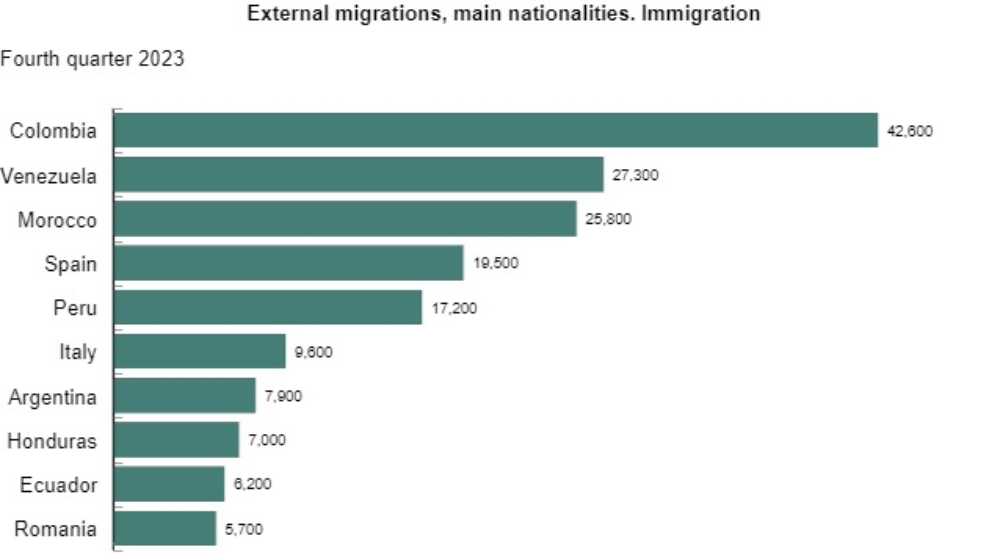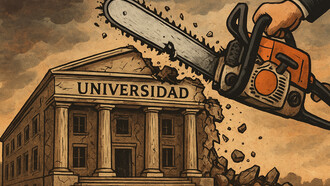A trip through the quarters of Madrid reveals a lot about the city’s social make up. Fancy restaurants in Salamanca, trendy nightclubs in Malasaña, and literary cafés in the aptly named La Latina all have a different feel created by the activities that characterise them. Each of these popular sort of establishments all have one thing in common: the famous 'lisp' of European Spanish seems to be disappearing.
An influx of Latin American migrants have made Madrid their home, and their presence has not gone unnoticed. Yes, there is more media coverage about the Arab and African immigrants or refugees in the EU and in Spain, but the number of Latin American immigrants continues to grow. The below chart is from the last quarter of 2023 alone.
Source: National Institute of Statistics
Qué pasa?
Traditionally, Cubans and Colombians were commonplace in Madrid. They had left their countries in search of better economic opportunities, or they were fleeing violence. Later, Dominicans made their barbershops famous and, to this day, the most common thing in a Spanish hospital are Latin American nurses from all over.
Factors in specific countries from the last decade have also contributed significantly to this immigration wave. The deterioration of democratic institutions in Venezuela and Nicaragua coupled with economic collapses like that of Argentina have prompted a massive exodus of people from their home countries.
These issues are so overtly known that at political rallies, immigrants fly the flag of their home countries and politicians like Isabel Diaz Ayuso and Cayetana Álvarez de Toledo openly appeal for the Venezuelan and Argentinian vote. Not for nothing, Madrid is a mandatory stop for Latin American politicians trying to sway the overseas voter.
It must be noted that not all Latin American immigrants in Madrid or Spain came by need—some came by choice. After all, it is a great place to live, and it is the economic engine of Spain.
Millionaire investors have obtained residence in Spain after paying the hefty investment sum qualifying for a 'Golden Visa'. The most famous of these investors is easily the telegenic Mexican ex-president Enrique Peña Nieto. Of course, most are low-profile, but their presence has also been felt with their gentrification of middle-class areas and a rise in cost of living.
This new market of consumers has generated new opportunities for business. Not only are there more and more little shops selling imported products 'from back home', but there are also major restaurants. Three Michelin Star-winning Peruvian chef Gastón Acurio has announced a new site for his seafood restaurant La Mar right in front of Real Madrid’s soccer stadium, the Santiago Bernabeu. Talk about bridging Latin America and Madrid.
The cultural revolution
This trend is much more than people moving to Spain. There has also been a quiet cultural revolution of Latin America in Spain. Products, more than people, have deeply influenced the Spanish market. For example, Reggaetón is the sound of the streets, and Puerto Rican and Colombian singers compete yearly for the next summer anthem. Mexican corridos are also starting to become immensely popular too with stars like Peso Pluma.
On a historical note Latin American literature has always been a constant in Spain. Every year, the quaint stands of the Madrid Book Fair that surround the Retiro Park are full of Latin American authors.
As a matter of fact, plenty of Latin American writers have lived in Spain at one point in their careers. These include the father of Modernism Nicaraguan Rubén Darío, the Colombian Nobel laureate García Márquez, and the Paraguayan master Augusto Roa Bastos. Contemporary authors include the exiled Nicaraguan Sergio Ramírez and the Peruvian 'survivor of the boom' Vargas Llosa, who calls Madrid home and even holds Spanish citizenship.
Finally and, although it goes without saying, it has to be said—all Latin Americans follow Spanish soccer. Kids grow up watching the Spanish league and remain faithful to one team their entire lives. This is true to a point that the way kids make friends in the school playground is by asking, 'Barça o Madrid?' (Barça fan here btw).
Reasonable explanations
When trying to explain the phenomenon of Madrid being a Latin American metropolis, a number of reasons seem feasible. One is the obvious cultural similarities. After all, Spanish-speaking countries used to be one huge empire with a common language, religion, laws, government, and even diet. No wonder acculturation is very easy as opposed to the U.S., for example. If lax visa restrictions and an easy path for naturalisation are also considered, it makes Spain a good option for Latin Americans to try their luck. On top of this, the solid institutions and stability of Spain offer long term opportunities which is not a case in the volatile Latin American political scenario.
If Spain discovered the Americas, then in a sense, Latin Americans are now discovering Spain.
















